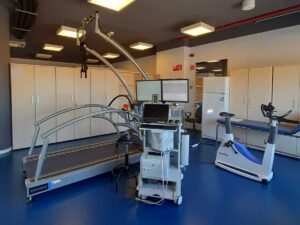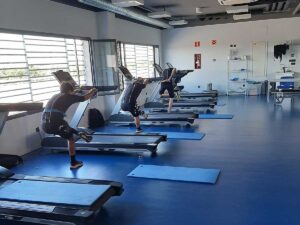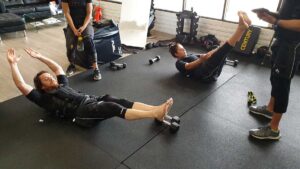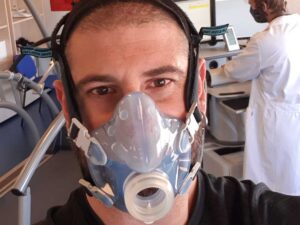Low-frequency EMS has been used for rehabilitation and recovery for many years. EMS is thought to increase blood flow and accelerate the elimination of muscle metabolites (Lattier et al., 2004). EMS activates muscle pumps in the limb, resulting in increased flow and velocity of blood volume and capillary action (Tucker et al., 2010).
Following this line, WB-EMS is a new therapeutic strategy with promising results on body composition and functional capacity (Kemmler et al., 2018). However, despite the promising results acquired in several studies, to date, there is still a lack of knowledge in the acute physiological responses produced by WB-EMS in blood flow or blood lactate concentration. Therefore, the objective of this study is to show whether active recovery with WB-EMS can alter the characteristics of blood flow in the legs by Doppler ultrasound.
For this study, a randomized trial was conducted with all participants using the WB-EMS suit. Participants performed a maximal gradual exercise test on a treadmill followed by an active recovery exercise protocol.
Therefore, to determine if the use of WB-EMS could offer additional benefits during recovery, 33 participants were randomized for this study, the experimental group (n = 18) underwent continuous low-frequency stimulation (7Hz). and a pulse width of 350 µs with WB-EMS (quadrangular, bipolar and compensated wave), while the participants in the control group (n = 18) did not receive an electrical stimulus. Also, clinical details were collected that included the subject’s age, weight, height, body composition, and vascular function results. Laboratory personnel were blinded to group assignment.
Before workouts, subjects wore a heart rate monitor to record heart rate during the protocol. After a 10-minute rest period, anthropometric characteristics, body composition, heart rate, blood lactate concentrations, pain and discomfort levels, and baseline hemodynamic measurements were recorded before performing the maximum gradual test in a treadmill. After the test, the measurements were repeated and the participants underwent an active recovery protocol on the treadmill at 40% of their maximum aerobic speed. Immediately after the recovery period, hemodynamic and lactate measurements were taken in the supine position, and then the measurements were repeated 30 and 60 minutes after recovery in the sitting position.
When analyzing the results of this study, they showed how the peak blood velocity (PBV) was substantially higher in the group with WB-EMS than in the control group.
After 60 minutes of the recovery process, the renal resistive index (IR) decreased substantially more in the WB-EMS group than in the control group. Furthermore, the levels of discomfort and pain at this point were also lower in the WB-EMS group than in the control group. However, 30 and 60 minutes after the maximum gradual test, no significant differences in blood lactate were observed in the WB-EMS group compared to the control group. Finally, participants in the WB-EMS group increased blood lactate levels by 15% more than the control group, and these levels remained high during recovery.
In view of the results, this study could have several important practical implications for physical performance, as WB-EMS can be easily included to improve recovery after intense exercise and can do so to a greater extent than traditional active recovery. Therefore, WB-EMS could be used in situations where traditional strategies are not possible, especially in sporting events that use short recovery periods as in team sports that could improve blood flow and resistive index levels.
On the other hand, no significant differences were found in lactate clearance. However, taking into account a study mentioned in a systematic analysis where a balanced, biphasic rectangular wave with a frequency of 2 Hz was applied for 20 minutes, positive effects were found in lactate clearance (Babault et al., 2011) . Taking into account all of the above, it is necessary to apply more studies along these lines to reach a definitive conclusion.
BIBLIOGRAPHY
- Borja Sañudo, Diego Bartolomé, Sergio Tejero, Jesus Gustavo Ponce-González, Juan Pedro Loza and Arturo Figueroa. (2020). Impact of Active Recovery and Whole-Body Electromyostimulation on Blood-Flow and Blood Lactate Removal in Healthy People. Frontiers in Physiology, 11, 1-8.
- Lattier, G., Millet, G. Y., Martin, A., and Martin, V. (2004). Fatigue and recovery after high-intensity exercise. part II: recovery interventions. Int. J. Sports Med. 25, 509–515. doi: 10.1055/s-2004-820946.
- Tucker, A., Maass, A., Bain, D., Chen, L. H., Azzam, M., Dawson, H., et al. (2010). Augmentation of venous, arterial and microvascular blood supply in the leg by isometric neuromuscular stimulation via the peroneal nerve. Int. J. Angiol. 19, e31–e37. doi: 10.1055/s-0031-1278361
- Kemmler, W., Weissenfels, A., Willert, S., Shojaa, M., von Stengel, S., Filipovic, A., et al. (2018). Efficacy and safety of low frequency whole-body electromyostimulation (WB-EMS) to improve health-related outcomes in non- athletic adults. A systematic review. Front. Physiol. 9:573. doi: 10.3389/fphys. 2018.00573
- Babault, Nicolas Cometti, Carole Maffiuletti et al. (2011). Does electrical stimulation enhance post-exercise performance recovery? European Journal of Applied Physiology 111:2501–2507







